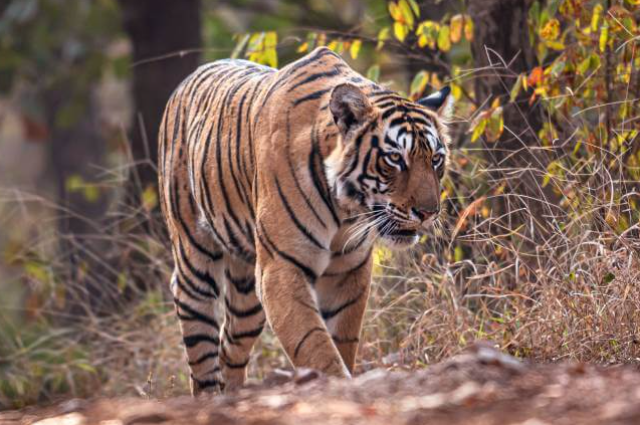Once upon a time, in the deep forests of Ranthambore National Park, lived a royal tigress named Arrowhead. But wait, before we jump into her story, let’s talk about tigers a bit.
Did you know India has the most tigers in the world? Yup, more than 70% of all the tigers on Earth live here. That’s why India made the tiger its national animal back in April 1973. It’s like saying, “You’re not just a cool cat—you’re the cat!”
Tigers are called by different names in different parts of India. In Hindi, it’s baagh, in Tamil and Telugu, it’s puli, and in Punjabi and Urdu, people call them sher. But no matter what you call them, everyone agrees: tigers are amazing.
The Bengal Tiger – King (or Queen) of the Jungle
The most famous tiger in India is the Bengal tiger. These big cats are found in many parts of the country, except very dry or cold places like the Thar Desert, Ladakh, and parts of Punjab or Gujarat.
And they’re huge—like, “I’ll-eat-three-buffaloes-for-breakfast” huge. Because of their size and power, they’re called Royal Bengal Tigers. One of them, Arrowhead, became super famous—not just because of her looks, but because of her bravery.
Meet Arrowhead: Born to Be Wild (and Brave!)
Arrowhead was born in 2014 in Ranthambore. Her family was basically tiger royalty. Her grandmother was Machli, the most famous tigress in the world. Machli once fought a crocodile and won. Yes, you read that right—a crocodile! She was called the “Lady of the Lake” and lived till 19 years, which in tiger years is like a grandma who still does karate.
Arrowhead’s mother was Krishna (T-19), and she was brave too. So you can say bravery ran in the family—like it was passed down with the stripes!
Arrowhead got her name from the arrow-shaped mark on her forehead. She was smart, fast, and didn’t get scared of people. Tourists loved her. She’d just walk around like a queen, while people clicked selfies (from far away of course… no tiger hugs allowed!).
A Brave Mom
Arrowhead became a mother and gave birth to three cubs. She taught them how to hunt, how to survive, and probably how to growl at tourists politely. She protected them like any mom would—even if her kids were busy chasing butterflies or biting each other’s tails.
People said she was just like Machli—brave, beautiful, and very cool. Some even joked that she deserved a movie, maybe called “Arrowhead: The Real Jungle Queen.”
Getting Older, But Still Brave
As years passed, Arrowhead started getting sick. She wasn’t eating much, and she looked weak. Forest officers checked her and found out she had a brain tumour and bone cancer—two very serious diseases. She had trouble walking and hunting, so the forest team began feeding her meat. Imagine being royalty and having food served to you every day—Arrowhead was basically in a five-star forest hotel!
But then things got tricky. One of her cubs became too aggressive and attacked a forest worker. The feeding had to stop to keep everyone safe.
Still, Arrowhead did not give up. On the last day of her life, something amazing happened. Even though she was weak and sick, she fought and killed a crocodile—just like her grandmother did. It was like a final roar: “I may be old, but I’m still the queen!”
Just an hour before she died, her cubs were moved to another area for their safety. Arrowhead passed away on June 19 at the age of 11—a long life for a wild tiger.
A Funny, Furry Legend
Arrowhead was one of the most famous tigers in Ranthambore, after her grandma Machli. She was calm, beautiful, and very photogenic—probably had more pictures clicked than most Bollywood stars! She never attacked tourists or ran away from cameras. In fact, she might have thought, “Strike a pose? Sure, but only from my good side!”
She was strong when young, caring as a mother, and brave even in sickness. If there was a superhero team of jungle animals, Arrowhead would totally be the leader—maybe wearing a cape made of leaves!
Roars, Respect, and Remembrance
Arrowhead’s story is not just about a tiger. It’s about courage, family, and survival. She showed us that being brave isn’t just about fighting—it’s about caring, protecting, and standing strong even when life gets hard.
So next time you see a tiger in a picture or on TV, remember Arrowhead. She wasn’t just a wild animal. She was a true hero with stripes.
And hey, if you ever visit Ranthambore, look out for her cubs. Who knows? Maybe one of them is walking around thinking, “Time to make Grandma and Mom proud!”

